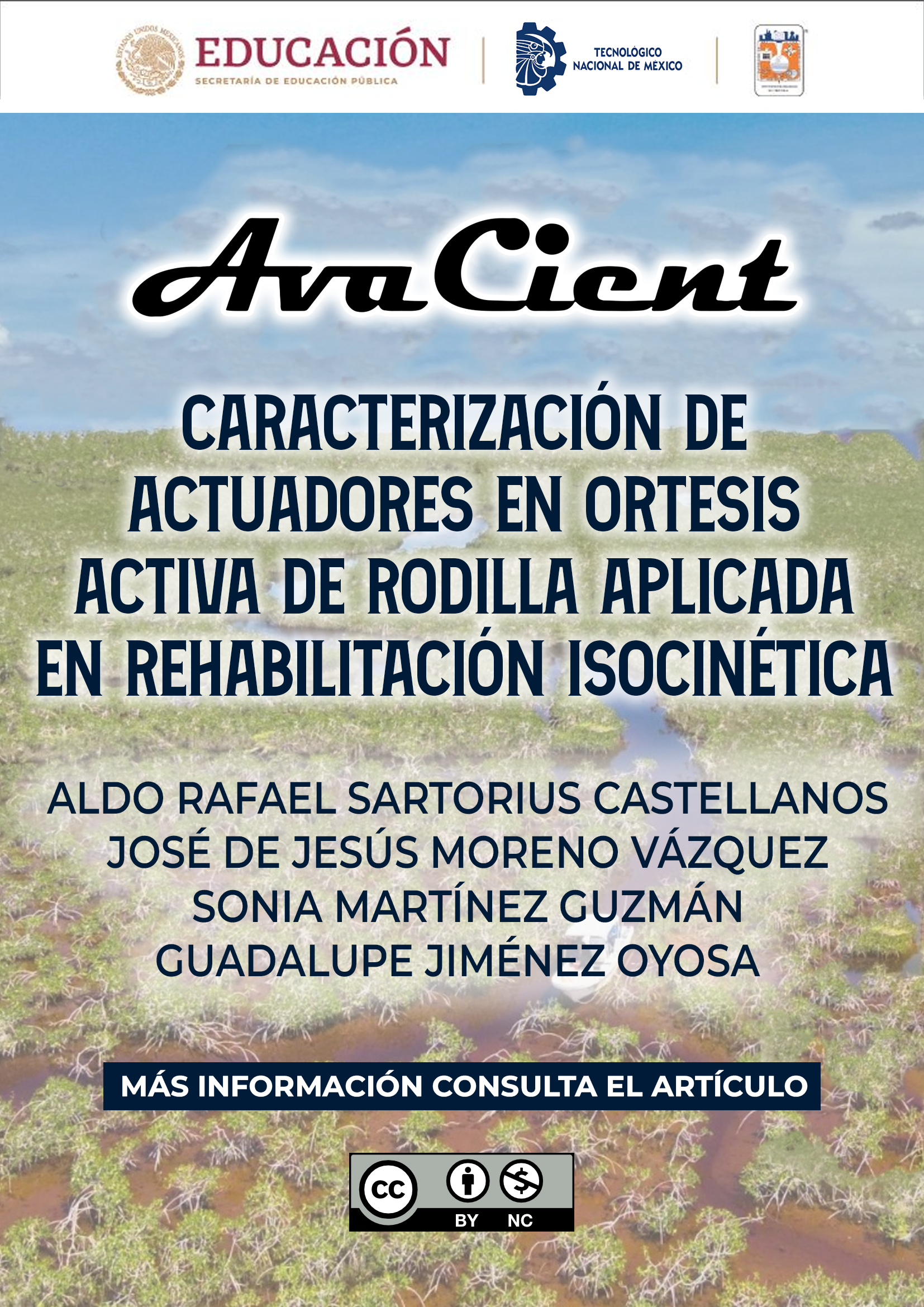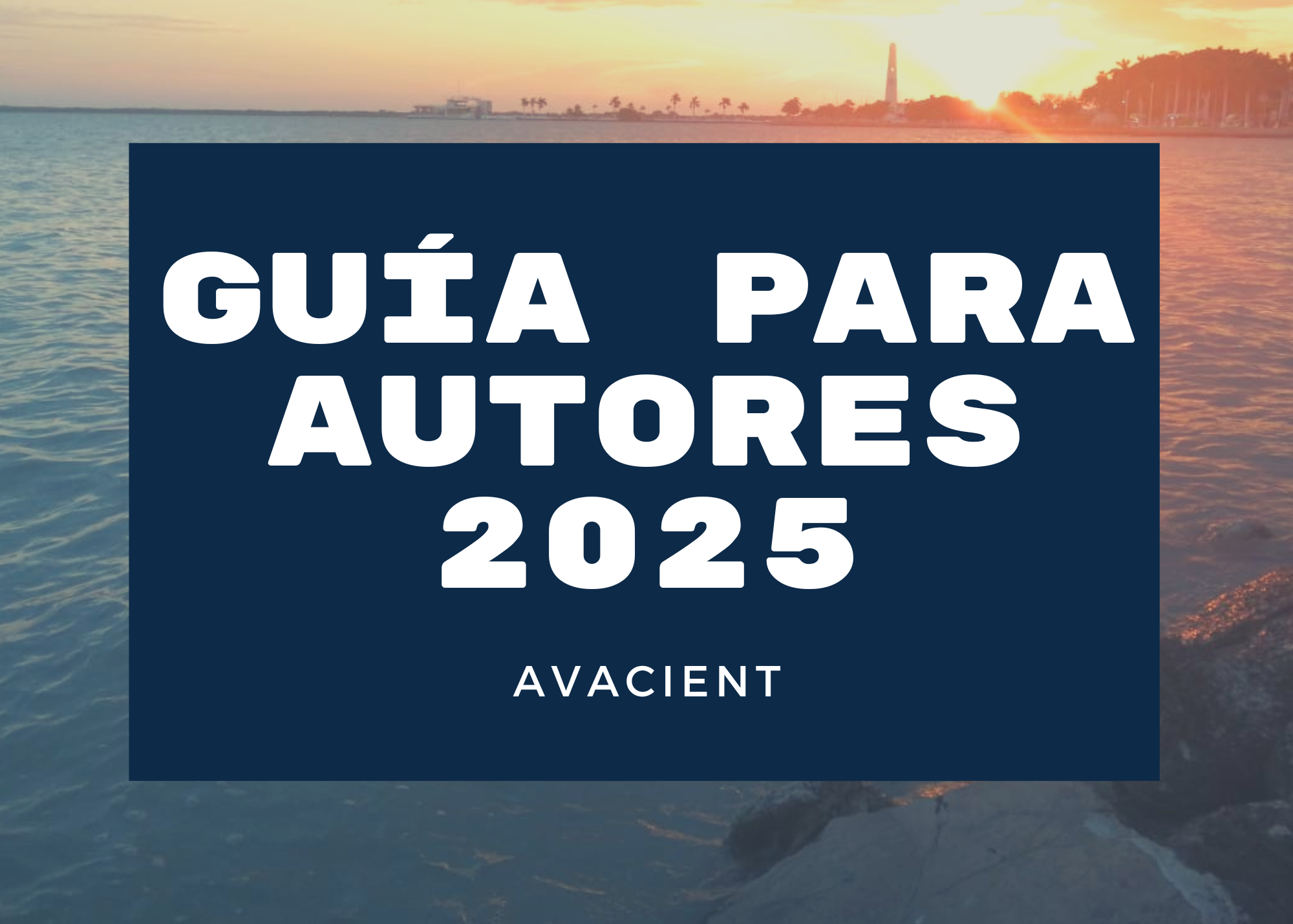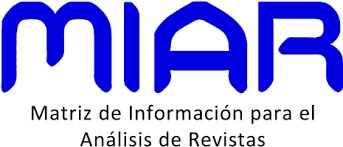CARACTERIZACIÓN DE ACTUADORES EN ORTESIS ACTIVA DE RODILLA APLICADA EN REHABILITACIÓN ISOCINÉTICA
DOI:
https://doi.org/10.69823/avacient.v4n2a7Keywords:
Actuadores, Discapacidad, Isocinética, Ortesis, RehabilitaciónAbstract
En México, la discapacidad relacionada con los problemas de movilidad y específicamente a caminar afecta a una gran parte de la población, especialmente a adultos mayores y adultos, debido principalmente a lesiones en las rodillas causadas por diversos factores como accidentes, actividades deportivas o enfermedades crónico degenerativas como la osteoartritis. La rehabilitación post-lesión o después de una cirugía de rodilla, es crucial para recuperar la movilidad y fuerza muscular. La dinamometría isocinética es un enfoque común en la rehabilitación en general y específicamente de miembros inferiores. Consiste en mantener una velocidad constante durante la flexión o extensión de la rodilla, y compensar el torque producido por el paciente durante todo el rango del movimiento. El torque producido por los músculos del paciente, depende de factores como la edad y el sexo, y varía significativamente entre deportistas, personas no entrenadas y pacientes mayores. Así mismo, dicho torque depende de manera muy significativa de la velocidad requerida durante la extensión o la flexión de la rodilla. Esta investigación tiene como objetivo determinar los torques máximos a diferentes velocidades, considerando el sexo y el percentil de la población, para dimensionar adecuadamente los actuadores necesarios en equipos portátiles de rehabilitación isocinética.
Downloads
References
INEGI «Censo de Población y Vivienda 2020». Accedido: 22 de agosto de 2024. [En línea]. Disponible en: https://www.inegi.org.mx/programas/ccpv/2020/#Tabulados
K. E. DeHaven y D. M. Lintner, «Athletic injuries: Comparison by age, sport, and gender», Am. J. Sports Med., vol. 14, n. o 3, pp. 218-224, may 1986, doi: 10.1177/036354658601400307.
Instituto Mexicano del Seguro Social (IMSS), «Manejo de las lesiones ligamentarias traumáticas en rodilla», 2010. Accedido: 22 de agosto de 2024. [En línea]. Disponible en: http://coescamedcolima.mx/guias/Guias_archivos_pdf/IMSS-388-10-ER.pdf
A. P. Vertti et al., «Factores de riesgo en osteoartritis de rodilla en una población mexicana de casos y controles», Rev. Cuba. Ortop. Traumatol., vol. 27, n. o 1, pp. 22-32, jun. 2013. [En línea]. Disponible en: http://scielo.sld.cu/scielo.php?script=sci_arttext&pid=S0864-215X2013000100003
A. Mayo Astudillo, «Osteoartritis de rodilla y su frecuencia con discapacidad laboral evaluación por escala MSH1», 2010, [En línea]. Disponible en: http://cdigital.uv.mx/bitstream/123456789/32322/1/mayo%20astudillo.pdf
A. Slocker De Arce, J. Carrascosa Sánchez, F. J. Fernández Camacho, C. Clemente De Arriba, y L. Gómez Pellico, «Análisis isocinético de la flexo-extensión de la rodilla y su relación con la antropometría del miembro inferior», Rehabilitación, pp. 86-92, doi: 10.1016/S0048-7120(02)73247-7.
R. Nisell, «Mechanics of the Knee», Acta Orthop. Scand., vol. 56, n. o sup216, pp. 1-42, ene. 1985, doi: 10.3109/17453678509154159.
M. D. S. Andrade, C. A. B. De Lira, F. D. C. Koffes, N. C. Mascarin, A. A. Benedito-Silva, y A. C. Da Silva, «Isokinetic hamstrings-to-quadriceps peak torque ratio: the influence of sport modality, gender, and angular velocity», J. Sports Sci., vol. 30, n. o 6, pp. 547-553, 2012, doi: 10.1080/02640414.2011.644249.
S. Almosnino, J. M. Stevenson, D. D. Bardana, E. D. Diaconescu, y Z. Dvir, «Reproducibility of isokinetic knee eccentric and concentric strength indices in asymptomatic young adults», Phys. Ther. Sport Off. J. Assoc. Chart. Physiother. Sports Med., vol. 13, n. o 3, pp. 156-162, ago. 2012, doi: 10.1016/j.ptsp.2011.09.002.
M. G. Parker, «Calculation of Isokinetic Rehabilitation Velocities for the Knee Extensors», J. Orthop. Sports Phys. Ther., vol. 4, n. o 1, pp. 32-35, jul. 1982, doi: 10.2519/jospt.1982.4.1.32.
D. A. Klopfer y S. D. Greij, «Examining quadriceps/hamstrings performance at high velocity isokinetics in untrained subjects», J. Orthop. Sports Phys. Ther., vol. 10, n.o 1, pp. 18-22, 1988, doi: 10.2519/jospt.1988.10.1.18.
M. G. Bemben et al, «Assessment of Technical Accuracy of the Cybex II® Isokinetic Dynamometer and Analog Recording System», J. Orthop. Sports Phys. Ther., vol. 10, n. o 1, pp. 12-17, jul. 1988, doi: 10.2519/jospt.1988.10.1.12.
«System 4 Pro TM - Dynamometers - Physical Medicine | Biodex». Accedido: 22 de agosto de 2024. [En línea]. Disponible en: http://www.biodex.com/physical-medicine/products/dynamometers/system-4-pro
J. Breno de Araújo Ribeiro Alvares et al., Inter-machine reliability of the Biodex and Cybex isokinetic dynamometers for knee flexor/extensor isometric, concentric and eccentric tests, vol. 16. 2014. doi: 10.1016/j.ptsp.2014.04.004.
K. L. N. English, «Comparison of Knee and Ankle Dynamometry between NASA’s X1 Exoskeleton and Biodex System 4», 1 de mayo de 2014. [En línea]. Disponible en: https://ntrs.nasa.gov/search.jsp?R=20140003281
B. Stark, P. Emanuelsson, U. Gunnarsson, y K. Strigård, «Validation of Biodex system 4 for measuring the strength of muscles in patients with rectus diastasis», J. Plast. Surg. Hand Surg., vol. 46, n. o 2, pp. 102-105, abr. 2012, doi: 10.3109/2000656X.2011.644707.
H. Rifaï, S. Mohammed, K. Djouani, y Y. Amirat, «Toward Lower Limbs Functional Rehabilitation Through a Knee-Joint Exoskeleton», IEEE Trans. Control Syst. Technol., vol. 25, n. o 2, pp. 712-719, mar. 2017, doi: 10.1109/TCST.2016.2565385.
S. Mefoued, S. Mohammed, y Y. Amirat, «Knee joint movement assistance through robust control of an actuated orthosis», en 2011 IEEE/RSJ International Conference on Intelligent Robots and Systems, sep. 2011, pp. 1749- 1754. doi: 10.1109/IROS.2011.6094893.
T. Bacek, M. Moltedo, K. Langlois, C. Rodriguez-Guerrero, B. Vanderborght, y D. Lefeber, «A novel modular compliant knee joint actuator for use in assistive and rehabilitation orthoses», en 2017 IEEE/RSJ International Conference on Intelligent Robots and Systems (IROS), sep. 2017, pp. 5812-5817. doi: 10.1109/IROS.2017.8206472.
Cestari M., Sanz-Merodio D., Garcia E, «A New and Versatile Adjustable Rigidity Actuator with Add-on Locking Mechanism (ARES-XL) », Actuators, vol. 7, n. o 1, 2018. doi: 10.3390/act7010001.
H. Zhu, C. Nesler, N. Divekar, M. T. Ahmad, y R. D. Gregg, «Design and Validation of a Partial-Assist Knee Orthosis with Compact, Backdrivable Actuation», en 2019 IEEE 16th International Conference on Rehabilitation Robotics (ICORR), jun. 2019, pp. 917-924. doi: 10.1109/ICORR.2019.8779479.
D.-H. Moon, D. Kim, y Y.-D. Hong, «Development of a Single Leg Knee Exoskeleton and Sensing Knee Center of Rotation Change for Intention Detection», Sensors, vol. 19, n. o 18, Art. n. o 18, ene. 2019, doi: 10.3390/s19183960.
A.M. Khomami y F. Najafi «A survey on soft lower limb cable-driven wearable robots without rigid links and joints» Robotics and Autonomous Systems, vol. 144, 2021, doi: 10.1016/j.robot.2021.103846.
Kim, Hyung Joo, Jaeho Noh, y Woosung Yang. 2020. "Knee-Assistive Robotic Exoskeleton (KARE-1) Using a Conditionally Singular Mechanism for Industrial Field Applications" Applied Sciences 10, no. 15: 5141. https://doi.org/10.3390/app10155141
P. T Chinimilli et al, «Automatic virtual impedance adaptation of a knee exoskeleton for personalized walking assistance», Robotics and Autonomous Systems, vol. 114, 2019, pp. 66-76. doi: doi.org/10.1016/j.robot.2019.01.013.
S. Chen et al., «Adaptive Robust Cascade Force Control of 1-DOF Hydraulic Exoskeleton for Human Performance Augmentation», IEEEASME Trans. Mechatron., oct. 2016, doi: 10.1109/TMECH.2016.2614987.
E. Rogers-Bradley, P. Polygerinos, S. Allen, F. Panizzolo, C. Walsh, y D. Holland, «A Quasi-Passive Knee Exoskeleton to Assist During Descent», en Biosystems and Biorobotics, vol. 16, 2017, pp. 63-67. doi: 10.1007/978- 3-319-46532-6_11.
Ashmi. M. Mathias, M. Anila, y K. S. Sivanandan, «Comparison of SMC and PID Controllers for Pneumatically Powered Knee Orthosis», J. Control Autom. Electr. Syst., vol. 32, jul. 2021, doi: 10.1007/s40313-021-00775-0.
C. N. Lescano Pastor, «Plataforma de desarrollo de órtesis robótica para rehabilitación de marcha: aplicación a un caso de estudio de Mielomeningocele». Universidad Nacional de San Juan, 2017. Accedido: 11 de junio de 2024. [En línea]. Disponible en: https://ri.conicet.gov.ar/handle/11336/157970
J.-S. Oh y S.-B. Choi, «State of the art of medical devices featuring smart electro-rheological and magneto- rheological fluids», J. King Saud Univ. - Sci., may 2017, doi: 10.1016/j.jksus.2017.05.012.
M. Reyes-García et al., «Defining the Final Angular Position of DC Motor shaft using a Trapezoidal Trajectory Profile», en 2019 IEEE 28th International Symposium on Industrial Electronics (ISIE), jun. 2019, pp. 1694-1699. doi: 10.1109/ISIE.2019.8781093.
S. Thirachai, P. Komeswarakul, U. Supakchukul, y J. Suwatthikul, «Trapezoidal velocity trajectory generator with speed override capability», en ICCAS 2010, oct. 2010, pp. 1468-1472. doi: 10.1109/ICCAS.2010.5670142.
M. W. Spong, S. Hutchinson, y M. Vidyasagar, Robot Modeling and Control. John Wiley & Sons, 2020.
M. W. Spong y M. Vidyasagar, Robot Dynamics And Control. Wiley India Pvt. Limited, 2008.
R. Huston, Principles of Biomechanics. Boca Raton: CRC Press, 2008. doi: 10.1201/9781420018400

Downloads
Published
How to Cite
Issue
Section
License
Copyright (c) 2024 AvaCient

This work is licensed under a Creative Commons Attribution-NonCommercial 4.0 International License.
















